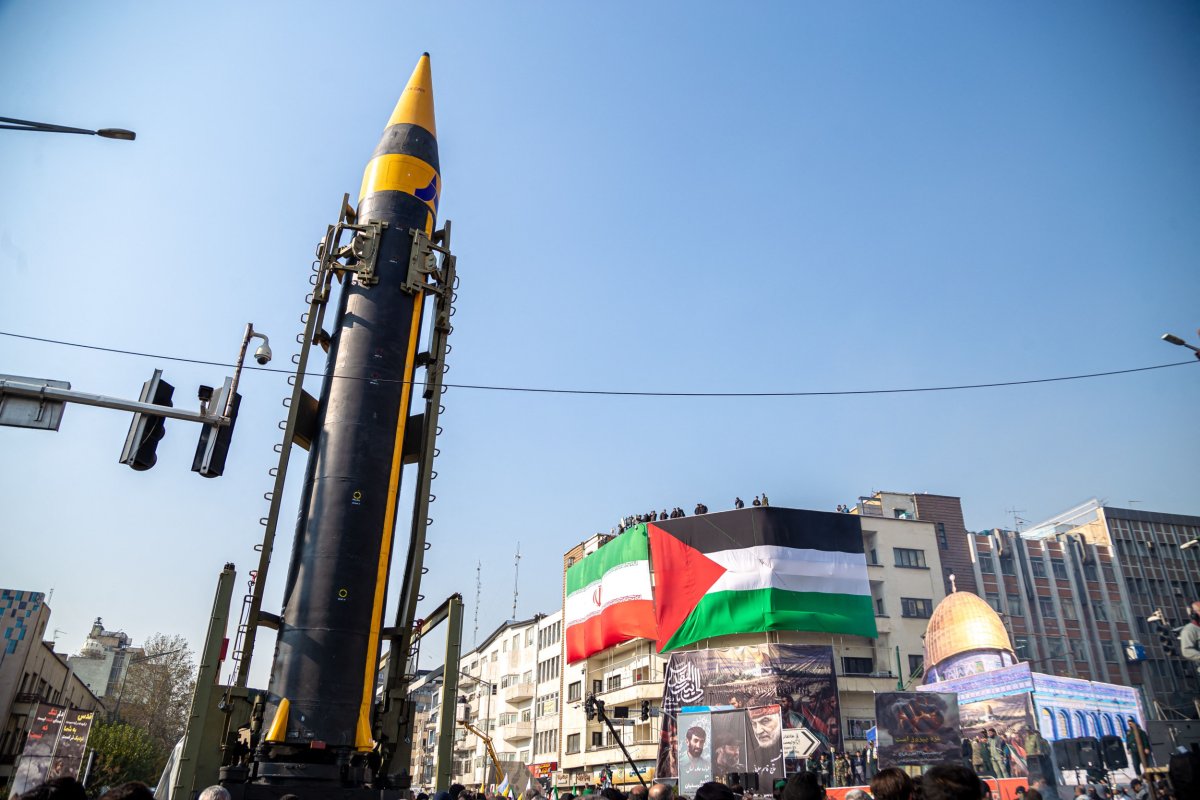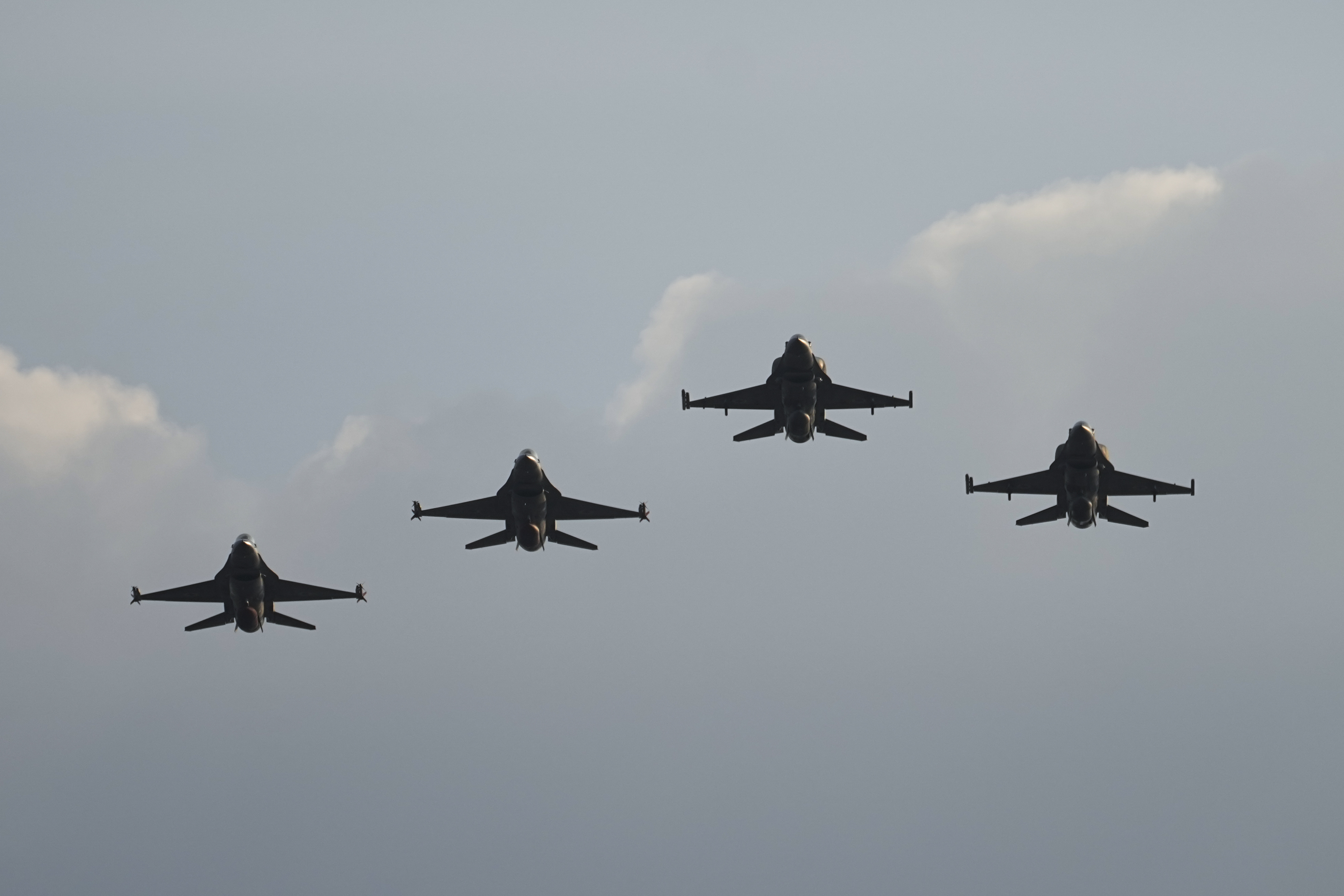🎙️ Voice is AI-generated. Inconsistencies may occur.
As the United States and Iran navigate new opportunities for diplomacy, they do so against the backdrop of both nations having simultaneously escalated their respective military rhetoric, with President Donald Trump suggesting potential direct strikes on the Islamic Republic if talks fail.
The tensions have put nearby Arab nations hosting U.S. troops on alert, but one tiny Indian Ocean island located 1,000 miles from the nearest landmass—and well over twice that from Iran—is receiving far more attention than usual. The lonely, secretive U.S. military outpost in United Kingdom-controlled Diego Garcia appears to have received as many as six B-2 U.S. stealth bombers in recent weeks as Trump ramped up warnings to Tehran over the actions of its Yemeni ally, Ansar Allah, also known as the Houthi movement.
Meanwhile, Iranian news outlets have taken a particular interest in Diego Garcia, discussing how it could be targeted in the event of a conflict. British newspaper The Telegraph cited senior Iranian officials late last month suggesting the island would be on the hit list should the simmering tensions turn to blows.
Now, just as the U.K. prepares to enter into a historic treaty to hand over control of the Chagos Islands archipelago, minus Diego Garcia, to one of its former colonies, the distant atoll with an already troubled past is being thrust onto the frontlines.
Every Kilometer Counts
While the initial round of U.S.-Iran diplomacy held in Oman last Saturday was deemed "constructive" by both sides, with another meeting set for this weekend, both sides appear committed to demonstrating their military might in the midst of talks.
The largest deployment of stealth bombers in U.S. history to Naval Support Facility Diego Garcia was accompanied by Iran's buildup of missiles on another set of contested islands in the Persian Gulf.
The Islamic Revolutionary Guard Corps (IRGC) Navy unveiled a number of new systems, including surface-to-surface and air defense platforms, in Abu Musa and the Greater and Less Tunb Islands, which are also claimed by the United Arab Emirates, as well as a new warship said to be capable of firing missiles hundreds of miles away at sea. The announcement followed extensive Iranian military drills, one of which involved the navies of China and Russia.
But with Diego Garcia located roughly 2,500-3,000 miles from launch sites in Iran, targeting the strategic U.S. base would necessitate far more range than the nation was known to possess. While Tehran has yet to showcase a platform capable of reaching such a distance, the nation with the largest and most advanced missile arsenal in the region has consistently demonstrated breakthroughs on such technology.
Behnam Ben Taleblu, senior fellow at the Foundation for Defense of Democracies, identified three possible methods through which Iran could feasibly extend its firepower to reach Diego Garcia.
The first involves Iran's Khorramshahr-4 medium-range ballistic missile, also known as Khaibar. While the weapon has a stated range of roughly 2,000 kilometers, or about 1,250 miles, less than half of what it would take to reach Diego Garcia, Taleblu argued that a "significantly modified" version of the Khorramshahr missile could potentially obtain the reach necessary to pose a threat to the U.S. firepower hub in the middle of the Indian Ocean.
He's not alone in predicting Iran's capability to substantially extend the range of the missile. In 2019, after Iran debuted the Khorramshahr-2, France, Germany and the U.K. jointly warned that a smaller reentry vehicle attached to the missile could likely bring its range closer to 3,000 kilometers.
Taleblu argued that Iran could conceivably bring the launching point even closer to Diego Garcia by transferring modified Khorramshahr missiles to Ansar Allah, the Yemeni faction of the broader Axis of Resistance coalition. While Iran and Ansar Allah have always denied any direct military ties, the Yemeni group has been firing missiles and drones toward Israel and commercial vessels at sea for nearly a year and a half since the outbreak of the war in the Gaza Strip on October 7, 2023.
Last week, Fars News Agency, a semi-official Iranian outlet often associated with the IRGC, published a heavily stylized portrayal of Khorramshahr-4 missiles raining down on Diego Garcia, producing a massive mushroom cloud explosion over the burning island.
A second option for Iran would be to use tankers or other commercial vessels converted to carry long-range drones, another area in which Iran has repeatedly demonstrated major breakthroughs. A drone swarm could potentially overwhelm even state-of-the-art defense systems likely to be positioned in and around Diego Garcia, where the extent of U.S. military assets remains undisclosed.
Finally, Taleblu explained, Iran could also potentially send out warships at sea to fire land-attack or anti-ship cruise missiles, such as the Abu Mahdi, to strike targets at Diego Garcia. He felt this was the least likely scenario, but, as with all of Iran's options, should not be dismissed outright by U.S. military planners.
"This is not the military that is frozen in time by sanctions," Taleblu told Newsweek. "They are trying to find as many offsets as possible, and in the asymmetric world, this is how they're doing it. So, I think we have to take the threat of it seriously, even though the capability may not be there yet, or the capability may not be a grade-A perfect military option in the way that we may see it.
"The perfect is not the enemy of the good when it comes to the way an adversary comes up with war plans, and just because something is not ideal or survivable or reliable, doesn't mean that an adversary would not consider it employable during a period of hostilities."

Never Underestimate Your Adversary
While a hypothetical conflict with Iran has factored into Pentagon planning for decades, Iran has continued to display its capacity to surprise onlookers with military action. Aside from Russia, which U.S. intelligence officials say has received scores of Iranian drones and missiles for use in its war in Ukraine, Iran has likely fired the most missiles in combat of any nation this century.
After the devastating 1980s war with Iraq in which the "War of the Cities" featured extensive exchanges of missile strikes between the neighboring rivals, Iran put its arsenal to use again in 2017 by targeting the Islamic State militant group (ISIS), in Syria. As tensions rose between Washington and Tehran in the wake of ISIS' defeat and Trump's exit from a 2015 nuclear deal during his first term, the U.S. leader ordered the killing of IRGC Quds Force commander Major General Qassem Soleimani in January 2020, prompting Iran to fire a massive volley of missiles at U.S. positions in Iraq.
Last year again proved unprecedented, as Iran fired missiles at four countries.
After Iran suffered the deadliest attack in its history at the hands of ISIS on the fourth anniversary of Soleimani's slaying, Iran launched missiles at suspected ISIS positions in Syria and alleged bases of Kurdish rebels and Israeli intelligence in northern Iraq. A day later, Iran conducted missile strikes against alleged separatist positions across its southeastern border with Pakistan, drawing retaliatory strikes against stated rebel sites in the Islamic Republic.
Then, last April, after Israel struck an Iranian diplomatic compound in Syria, Iran launched "Operation True Promise," the first direct Iranian attack on Israel, involving hundreds of missiles and drones, followed by Israel striking air defense sites in Iran. As tensions between Israel and Iran continued to soar over the multifront war in Gaza, "Operation True Promise II" was carried out involving an even larger wave of missile strikes against Israel, which struck back with its most intensive attacks on Iranian defenses to date.
Now, as Iranian officials continue to discuss what "Operation True Promise III" would look like and Israeli officials call for the U.S. to take preemptive action, Iranian analysts urge the White House not to overlook the Islamic Republic's willingness to respond with force even against nuclear-armed nations.
"It appears President Trump has underestimated Iran's military capabilities and lacks a clear understanding of the realities on the ground," Ali Bagheri Dolatabadi, a professor at the University of Tehran, told Newsweek.
"Some Israeli officials and political factions may be providing misleading information to encourage direct conflict with Iran. While Tehran does not seek war and remains open to resolving nuclear issues through negotiation, it has prepared itself for all scenarios. Trump seems to believe that Iran would respond weakly to provocations; however, this assumption is unlikely to hold true."
While he argued that Iran has already introduced the world to a number of its systems, including the Khorramshahr, in recent operations, he said that "it is important to note that publicized assets represent only a portion of Iran's arsenal."
"Iran reportedly possesses additional missiles that remain undisclosed to the media," Dolatabadi said. "These weapons have undergone successful testing phases and are gradually being revealed.
"For instance, few anticipated that Iran had underground missile cities until this information became public knowledge. Furthermore, Iran has developed hypersonic missiles like Fattah capable of precisely targeting military sites while bypassing advanced defense systems. This missile is continuously being upgraded, with limited details available about its specifications."
U.S. military planners have long sought to map out what such an asymmetric conflict would look like, sometimes finding limited success.
One notorious war game in 2002, during the leadup to the U.S. invasion of Iraq, resulted in the "Red Team"—the side simulating an unnamed enemy Persian Gulf nation—managing to overcome the far stronger "Blue Team"—the side representing the U.S.—using swarms of cruise missiles and fast-attack craft to sink much of the invading force. The "Red Team" leaders would go on to accuse the Pentagon of then unfairly scripting the exercise to ensure a U.S. victory.
Today, as "the U.S. prepares for potential Iranian retaliation at Diego Garcia Island," Dolatabadi pointed out that Washington "overlooks the vulnerability of its warships and bases within reach of Iranian forces," noting a number of exercises in which Iranian forces have practiced taking out key U.S. assets, such as aircraft carriers.
Tehran-based analyst Amir Hossein Vazirian argued that Iran was accustomed to the style of "gunboat diplomacy" Trump was currently employing, having faced similar situations dating to at least the 1950s. Even if Iran is ultimately outgunned, he warned, the fallout of a major conflict would prove extremely costly at a time when analysts are already raising concerns over the growing price and uncertain gains of the ongoing U.S. air war on Ansar Allah in Yemen.
"This is not about the United States and Iran's capabilities," Vazirian told Newsweek. "The best point in this context goes back to the cost and consequence of any full-blown war between Iran and the United States, and this factor can balance both sides.
"It's possible to underestimate the military potential of any power. For example, when the United States attacked Iraq in 2003, I don't think U.S. officials expected that for eight years the United States would have so many fatalities and such a cost in Iraq, and then they were forced to exit from Iraq."
As the U.S. again considers withdrawing troops from Iraq, the experience in Afghanistan also weighs on policymakers. The longest war in U.S. history ended in August 2021 with a decisive defeat for the allied government in Kabul and the Taliban swiftly retaking power after 20 years of insurgency.
Isolation As An Asset
In both U.S. wars, faraway Diego Garcia played a pivotal yet often understated role, serving as a hub for logistics, intelligence-gathering as well as a launching point for B-52 bombers and naval assets.
Milan Vego, professor of operations at the U.S. Naval War College, said that Diego Garcia "was used extensively during our operations over Afghanistan and Iraq, and I think it's importance is still there, nothing has really changed."
And while neither nation had anywhere near the capabilities that Iran now wields, he was skeptical that the Islamic Republic would be able to strike Diego Garcia with substantial effect, particularly given a lack of sophisticated over-the-horizon platforms and the presence of advanced U.S. detection systems.
"In my view, it will not be effective enough," Vego told Newsweek. "And I think any ship approaching the base will be discovered. It's a huge area. It is open. I think they have more chances to attack something that we have in Qatar or so on, because of the distance."
An attack on one or more of the many U.S. bases in the Middle East would be "a lot more difficult" to intercept "because your warning is much shorter." Still, he recognized that a strike on Diego Garcia was something that U.S. military planners should not rule out, particularly if Iran's "reasoning might be totally different than our reasoning."
Diego Garcia's distance has offered the U.S. other opportunities since the launch of the "War on Terror." In addition to hosting key power projection assets, including a maritime prepositioning ships squadron, Vego recalls how the island has been used by the CIA to maintain detention camps.
While the U.S. has never publicly confirmed Diego Garcia's controversial role as a CIA "black site" and stopover point for extraordinary rendition flights of terrorism suspects, growing evidence of this practice there prompted an investigation by the U.K. two decades ago. The findings of the probe appeared to contradict U.S. reassurances that reports of such practices at Diego Garcia were unfounded, but the details—as is the case with much of what happens on the island—remain shrouded in mystery to this day.
Newsweek reached out to U.S. Naval Support Facility Diego Garcia and the Mauritian Foreign Ministry for comment.

Unwanted Attention
There is another actor that has received considerably less attention in the current U.S.-Iran saga playing out over Diego Garcia.
When Diego Garcia was first encountered by Portuguese sailors in the early 16th century, during which it received its name, it was uninhabited. But as it changed hands between rival European powers, people began settling on Diego Garcia by the late 18th century, by force or by choice.
The Chagossians, which trace their origins to a mix of freed African slaves brought to the island under French rule, are considered by the United Nations to be the indigenous people of the Chagos Islands. In 1965, however, after granting independence to the East African island nation of Mauritius, through which Diego Garcia was long administered, the U.K. retained control of the archipelago and then began to forcefully displace the local population to make room for military installations.
The U.S. played a key role in this decision as it would go on to pursue its own massive buildup on the island, especially after the 1979 Islamic Revolution that deposed the last shah of Iran, who had earlier been restored to absolute power in a 1953 coup backed by London and Washington.
Chagossians, now numbering around 10,000 natives and their descendants largely living in the U.K., Mauritius and the Seychelles, have fought for decades to return, only to be met with British attempts to classify the archipelago as a marine nature preserve, precluding the possibility of resettlement. As of October 2024, however, the U.K. has begun finalizing a treaty with Mauritius that would cede control of the islands while retaining a joint 99-year lease with the U.S. for Diego Garcia.
Trump endorsed the agreement in February, but the deal has been met with mixed feelings by Chagossians still living in exile, some of whom have celebrated at the hope of returning to part of their formerly inhabited lands, while others see it as a setback for total decolonization. None were consulted in the negotiations.
"From the perspective of Chagossian Voices and the wider community, this agreement perpetuates a long and painful pattern of deciding the future of our homeland without our input," Frankie Bontemps, chair of the Chagossian Voices advocacy group, told Newsweek.
Bontemps said that his group was "not opposed to the U.S. military base on Diego Garcia," as he and others "recognize its strategic importance and are willing to coexist peacefully with the base, just as many civilians around the world live alongside military installations." He believed the base could offer "much-needed employment and opportunities for Chagossians seeking to return."
But at a time when Bontemps argued that Chagossians "want to live in peace on the land where our ancestors were born," he also expressed concern over how conversations around Diego Garcia were being dominated by themes of war.
"The Chagossian people are deeply concerned about how the Chagos Islands, especially Diego Garcia, are treated as a military asset in global conflicts that do not involve them," Bontemps said. "The recent deployment of stealth bombers linked to tensions with Iran highlights that critical decisions are made without considering those with strong historical and cultural ties to the land.
"This situation is unjust. Our homeland should not be a battleground or a bargaining chip; it is the ancestral home of a people who have already suffered forced displacement and exile. We want the Chagossians to safely return to their homeland."
Contacted for comment, British Indian Ocean Territory Commissioner Nishi Dholakia referred Newsweek to the U.K. Foreign, Commonwealth and Development Office (FCDO).
"Under the deal, the UK will retain full control over Diego Garcia," an FCDO spokesperson told Newsweek. "The deal protects UK and US national security interests and secures the future of the military base well into the next century, meaning it will continue to operate exactly as it does now."
"Mauritius will be able to develop a programme of resettlement for Chagossians to the islands, other than on Diego Garcia," the spokesperson added.

Update 4/15/2025 12:48 p.m. ET: This article has been updated to include comments from a spokesperson for the U.K. Foreign, Commonwealth and Development Office.
Is This Article Trustworthy?
Is This Article Trustworthy?
Newsweek is committed to journalism that is factual and fair
We value your input and encourage you to rate this article.
Newsweek is committed to journalism that is factual and fair
We value your input and encourage you to rate this article.
About the writer
Based in his hometown of Staten Island, New York City, Tom O'Connor is an award-winning Senior Writer of Foreign Policy ... Read more




